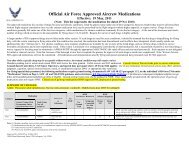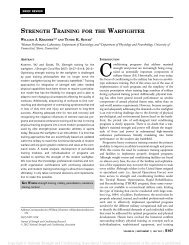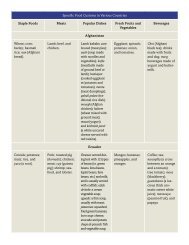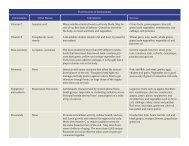Force Health Protection: Nutrition and Exercise Resource Manual
Force Health Protection: Nutrition and Exercise Resource Manual
Force Health Protection: Nutrition and Exercise Resource Manual
Create successful ePaper yourself
Turn your PDF publications into a flip-book with our unique Google optimized e-Paper software.
◆ Specific - The more specific the goal, the easier it is to plan your<br />
routines to reach the goal. If you have a general goal, pick a<br />
specific area to focus on. For example, define “I want to increase<br />
my running distance” to “I will increase my running distance by<br />
one mile.” Another example, restate “I want to increase my<br />
dietary fiber intake” as “I will add one additional serving each of<br />
fruits <strong>and</strong> vegetables to my daily diet”.<br />
◆ Measurable - Your specific goal should be easy for you to<br />
measure so you can chart your progress. Taking the running<br />
example above, you can easily measure the distance you run to<br />
determine if you are meeting your goal. As for the fiber example,<br />
you can record your fruit <strong>and</strong> vegetable intake (see Appendix A).<br />
◆ Action-oriented - When defining a specific goal state exactly<br />
what actions you must do to achieve the goal. This becomes your<br />
plan to reach your goals. For example, “I will increase my run by<br />
a quarter mile every two weeks until I am able to run an<br />
additional mile.”<br />
◆ Realistic - Be realistic in your expectations of yourself <strong>and</strong> what<br />
you expect to gain. Taking large or long-term goals <strong>and</strong> breaking<br />
them into smaller, more manageable goals to keep you motivated<br />
<strong>and</strong> focused on your actions. For example, train for <strong>and</strong> run a 5k<br />
race, then build up to a 10k race.<br />
◆ Timed - Time lines provide direction in planning short-term<br />
goals <strong>and</strong> actions to reach long-term goals <strong>and</strong> objectives. Using<br />
the running example above: two weeks is the deadline for<br />
increasing run distance by a quarter mile, <strong>and</strong> two months is the<br />
long-term deadline for increasing distance by one mile.<br />
Table 17-1 lists a number of general nutrition <strong>and</strong> fitness-related goals to assist<br />
you in identifying your own goals <strong>and</strong> in designing <strong>and</strong> setting “SMART”<br />
goals as described above.<br />
<strong>Nutrition</strong> <strong>and</strong> <strong>Exercise</strong> <strong>Resource</strong> <strong>Manual</strong> 123






![Body Composition and Military [PDF] - Human Performance ...](https://img.yumpu.com/43269347/1/190x245/body-composition-and-military-pdf-human-performance-.jpg?quality=85)
![Tips for Grocery Shopping [PDF]](https://img.yumpu.com/37447379/1/190x245/tips-for-grocery-shopping-pdf.jpg?quality=85)



![Synthetic Drugs [PDF] - Human Performance Resource Center](https://img.yumpu.com/37447322/1/190x245/synthetic-drugs-pdf-human-performance-resource-center.jpg?quality=85)


